 |
|

December 3-10, 2004
Binghamton's Ingraham Hill Revisited
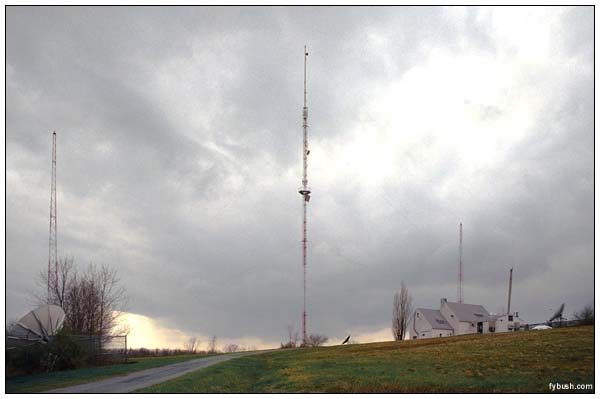 As we work our way through the
sites featured in the brand-new Tower Site Calendar
2005, now available right here at fybush.com, we can't resist the
opportunity to showcase the photo at right, which you'll find as the
January 2005 image in that fine publication.
As we work our way through the
sites featured in the brand-new Tower Site Calendar
2005, now available right here at fybush.com, we can't resist the
opportunity to showcase the photo at right, which you'll find as the
January 2005 image in that fine publication.
That's a view of the southernmost reaches of Ingraham Hill, south of Binghamton, N.Y., a site we featured in this space as one of the first Sites of the Week almost exactly four years ago. (December 20-27, 2000, if you must know...)
As we retrieved that presentation from the archives to share it with you again, we realized that so much has changed up there on the hill that we needed to bring you several new photos and a few new stories as well...so what we have here is a sort of a hybrid between a repeat and a new episode. As NBC used to say, "It's new to you!"
So without further preface, here's that 2000 Site of the Week - but then keep reading for all the new information and exciting new photos down at the bottom of the page, too, won't you?
High in the hills south of Binghamton, a stone's throw from the Pennsylvania line, sits the cluster of towers that supplies the region with all of its TV, most of its FM, and the market's top-rated AM.
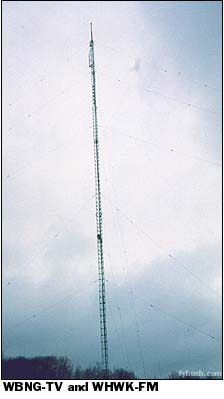 Ingraham Hill has been home to
broadcasting since at least 1949, when WNBF-TV 12 took to the airwaves
from the site shown at the top of the page. These three towers are also
home to WNBF (1290), with the middle tower having once been a Franklin
radiator (although it's no longer used in this way.) Was WNBF(AM) up on
the hill before its TV and FM counterparts? I honestly don't know...but
I'll be glad to update this page as soon as someone more knowledgeable
than I provides the answer. (2004 note: Keep reading - we answer that
question, and more, in our update at the bottom!) I do know that WNBF
is now running 9300 watts daytime from that center tower, up from the
original 5 kilowatts. (Night operation is still 5000 watts directional
from all three towers.)
Ingraham Hill has been home to
broadcasting since at least 1949, when WNBF-TV 12 took to the airwaves
from the site shown at the top of the page. These three towers are also
home to WNBF (1290), with the middle tower having once been a Franklin
radiator (although it's no longer used in this way.) Was WNBF(AM) up on
the hill before its TV and FM counterparts? I honestly don't know...but
I'll be glad to update this page as soon as someone more knowledgeable
than I provides the answer. (2004 note: Keep reading - we answer that
question, and more, in our update at the bottom!) I do know that WNBF
is now running 9300 watts daytime from that center tower, up from the
original 5 kilowatts. (Night operation is still 5000 watts directional
from all three towers.)
WNBF-FM dates from the same era as WNBF-TV. Originally on 44.9 and 100.5 MHz, the station settled down on 98.1 MHz, where it remains today as WHWK, playing country as "The Hawk." (During the 1970s and much of the 1980s, 98.1 was beautiful music WQYT.)
WHWK transmits with 10,000 watts from 960 feet above average terrain, just below the Channel 12 antenna in the picture to the left. Channel 12, of course, is no longer WNBF-TV, and hasn't been for decades. But as WBNG-TV, it still shares a site with its former radio partners. One more station joined them at this site in the late nineties. WYOS (104.1 Chenango Bridge) is a class A drop-in that uses 930 watts from 833 feet AAT, on the center tower of the WNBF array.
If the WNBF/WBNG site were the only thing on Ingraham Hill, it would be interesting but hardly distinctive. Thankfully (at least for those of us passionate about tower farms), it's hardly alone up there.
Just down Ingraham Hill Road is the tower that's home to three more TVs and several FMs.
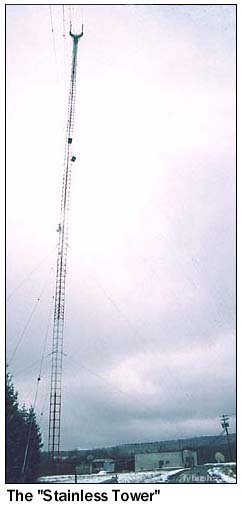 Binghamton broadcasters know this
one as the "Stainless tower," for the Pennsylvania-based tower firm that
built it when it bought the city's NBC affiliate, WINR-TV (Channel
40).
Binghamton broadcasters know this
one as the "Stainless tower," for the Pennsylvania-based tower firm that
built it when it bought the city's NBC affiliate, WINR-TV (Channel
40).
WINR-TV had been operating from the transmitter site of its sister station, WINR (680), on Windy Hill near the psychiatric center northeast of downtown Binghamton. That tower still stands, but it's not very tall, and it required viewers to swing their antennas around in order to tune away from dominant Channel 12. With just 575 kW visual from 630 feet above average terrain, the old channel 40 signal can't have been very impressive.
When WINR-TV became WICZ (the last four letters of the last name of Stainless' owner, Henry Guzewicz!), it moved to one tine of this big candelabra. By 1971, WICZ was running its 565 kW visual from a much more impressive 1,231 feet above average terrain.
Joining it on this tower (actually, preceding it by a few years) was Binghamton's new public television station. WSKG-TV (Channel 46) began broadcasting from the candelabra in 1968. WSKG-FM (89.3) came along in the seventies to join its TV sister, and it too uses this tower.
Next up on the big stick was WAAL (99.1), the former WKOP-FM, which had been using 33 kW from 440 feet in its previous incarnation (perhaps from the WKOP 1360 towers on a nearby hilltop in the Town of Binghamton?) before jumping up to the Stainless tower with a mighty 50 kW from 1090 feet AAT in the seventies, thus becoming Binghamton's most powerful FM signal.
A few more stations joined the Stainless tower family in the years that followed. A new class A station, WMXW (103.3 Vestal), signed on in 1989. A few years later, WICZ switched networks from NBC to Fox, leaving an affiliation hole that was soon filled by a new low-power TV station. WBGH-LP (Channel 8) operated from Ingraham Hill as well, initially as a simulcast of Elmira's WETM-TV (Channel 18), and later as a sister station of WIVT (Channel 34) - but read on for that story.
Trinity Broadcasting has an LPTV on the Stainless tower. Formerly on channel 14, it's now W26BS.
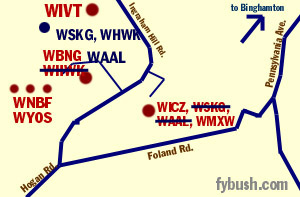 The most recent addition to the
hill came in 2000, when Owego's WLTB (101.7) changed city of license to
Johnson City and began operating from Ingraham Hill as well. (WLTB had a
102.5 translator on the hill for several years prior to moving its primary
signal.)
The most recent addition to the
hill came in 2000, when Owego's WLTB (101.7) changed city of license to
Johnson City and began operating from Ingraham Hill as well. (WLTB had a
102.5 translator on the hill for several years prior to moving its primary
signal.)
(A 2004 note on the map at left: it's been revised for this recap, with new towers and calls noted in blue. The original 2000 information is in red.)
There's still one more TV signal up on this hill, and its story just might be the most interesting of them all.
WBJA(TV) was originally allocated to channel 56, but it was able to move to channel 34 before its 1962 debut, thanks to the merger of two failing UHF stations an hour to the south. WILK-TV (Channel 34) in Wilkes-Barre gave up its allocation when it merged with WARM-TV (Channel 16) in Scranton to form the new WNEP-TV.
WBJA was an ABC affiliate, and for three decades the lowest-rated station in the market. It was also the only Binghamton station whose studios were up on Ingraham Hill.
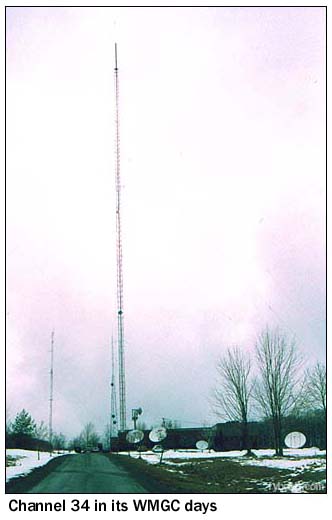 One NERW reader once related to
us the story of driving up the hill with other teenagers in the 1960s to
be part of the audience at WBJA's after-school "American Bandstand"-style
dance party, and the wild ride back down into town afterward.
One NERW reader once related to
us the story of driving up the hill with other teenagers in the 1960s to
be part of the audience at WBJA's after-school "American Bandstand"-style
dance party, and the wild ride back down into town afterward.
In the late seventies, WBJA was sold and became WMGC-TV, "Magic 34." Your editor fondly remembers the ID slide the station used circa 1980, featuring a pair of magician's hands, a rainbow, and the WMGC call letters. The new calls didn't do much for the ratings, and WMGC remained a ratings also-ran well into the nineties.
Then, in the space of just a few months in 1997 and 1998, everything changed at Channel 34. A new owner, Ackerley Broadcasting, took over and began investing money into the station's news operation. With resources shared with Ackerley powerhouse WIXT (Channel 9) up the road in Syracuse, the newly-renamed WIVT was poised to become a force in Binghamton news for the first time.
On the afternoon of Sunday, May 31, 1998, WIVT's revival came to a literal crashing halt. Tornado-force winds blew across Ingraham Hill, ripping holes in the channel 34 building as terrified master-control operators cowered beneath the board. Worse yet, when the board operators came up for air, they found the channel 34 tower demolished.
WIVT remained off the broadcast airwaves for several months, though a feed to local cable companies was back up and running with network programming within several days. Local programming resumed a few days later, from temporary studio space leased from WSKG-TV in Vestal.
Your editor drove up the hill about a week after the storm, to find a big blue tarp covering much of the damaged WIVT building and a guard with a pickup truck and a mean-looking dog suggesting we move on -- which we did!
By the fall, a new tower was up at the WIVT site, and broadcasting had resumed on channel 34.
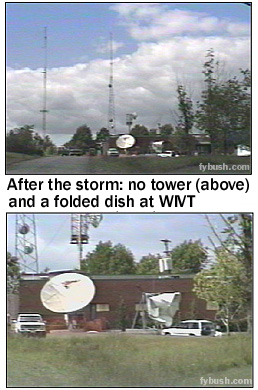 The damage to WIVT was the worst
on the hill, but other stations suffered as well. One of the
self-supporting towers in the WNBF array shown above (most of the pictures
on this page were taken on a snowy New Year's Eve 1995, long before the
storm) was toppled in the high winds. For quite a while thereafter, WNBF
operated with reduced power at night from the remaining two towers.
The damage to WIVT was the worst
on the hill, but other stations suffered as well. One of the
self-supporting towers in the WNBF array shown above (most of the pictures
on this page were taken on a snowy New Year's Eve 1995, long before the
storm) was toppled in the high winds. For quite a while thereafter, WNBF
operated with reduced power at night from the remaining two towers.
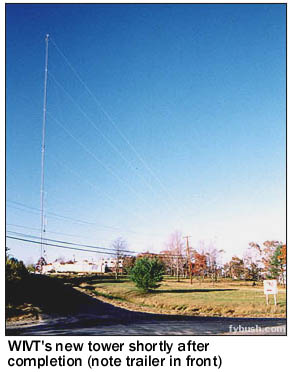 A few footnotes to our Binghamton
story: When digital TV comes to the Southern Tier, Binghamton will become
a mostly-VHF market for the first time in its history. WIVT-DT will be on
channel 4, matching its call letters and its cable dial position. WICZ-DT
will be on channel 8, and WBNG-DT on channel 7.
A few footnotes to our Binghamton
story: When digital TV comes to the Southern Tier, Binghamton will become
a mostly-VHF market for the first time in its history. WIVT-DT will be on
channel 4, matching its call letters and its cable dial position. WICZ-DT
will be on channel 8, and WBNG-DT on channel 7.
There are only three other FM sites of any significance in the Binghamton area. WMRV (105.7 Endicott) and WBBI (107.5 Endwell) use a tall tower in the hills north of Endicott, across the Susquehanna from the Ingraham Hill site. WSKG's sister station, WSQX (91.5), uses a tower near the Broome County BOCES facility just north of route 17 and west of downtown Binghamton. WKGB (92.5 Conklin), WCDW (100.5 Susquehanna PA), and WJIK (90.1 Binghamton) are on a short, hard-to-find tower far to the east of Binghamton in West Windsor, a few miles off route 17. Oddly, Binghamton's other AM stations are also up in the hills. WINR (680) we've already covered; WKOP (1360) is just a short drive away from Ingraham Hill in the town of Binghamton; and WENE (1430 Endicott) has a distinctive five-tower array south of Vestal Parkway near route 26 in Vestal. We'll make the Binghamton AMs a Site of the Week sometime next year...
OK - back to 2004 now. (My, how time flies!)
So much has changed on Ingraham Hill in just four years that it's hard to know where to start - so we'll begin with some history, first: Bruce Fanning checked in from southern Colorado to share some of his knowledge of his hometown sites, and since his career included stops at most of these stations, we're delighted to be able to benefit from his expertise. Bruce notes that WNBF began its long history down in the valley below, signing on in 1927 on 1450 kHz and spending the thirties on 1500 kHz with 250 watts. By 1936, it was operating from a tower on the west side of Binghamton.
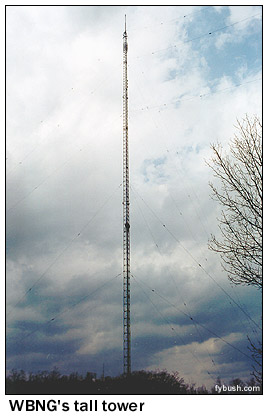 The NARBA shift of March 29, 1941
would have moved WNBF to 1490, but if it ever operated there, it wasn't
for long - by September, WNBF had begun construction on the Ingraham Hill
site, which saw it move to 1290 with 5,000 watts. Now, here's where it
begins to get interesting: back then, all four of the towers on
that site were used as part of the AM array, including that thousand-foot
monster that's now used by WBNG-TV! It seems that the big stick, though
built with eventual TV use in mind, was also a Franklin antenna, fed at
the center insulator. And the middle tower in what's now WNBF's
three-tower array was center-fed, too. Here's Bruce: "The middle tower
is twice the hight of the self supporting towers, like the Franklin this
middle tower has insulators halfway up, but it was (I don't know about
today, but I would bet it's still the same) feed at the base of the tower.
Three relays, one on each leg, "break" it in half electrically. The 2 self
supporting towers and the bottom half of the middle tower are used for
nighttime directional operation. Close the relays and this middle tower
became live top to bottom and was the backup for the Franklin.
The NARBA shift of March 29, 1941
would have moved WNBF to 1490, but if it ever operated there, it wasn't
for long - by September, WNBF had begun construction on the Ingraham Hill
site, which saw it move to 1290 with 5,000 watts. Now, here's where it
begins to get interesting: back then, all four of the towers on
that site were used as part of the AM array, including that thousand-foot
monster that's now used by WBNG-TV! It seems that the big stick, though
built with eventual TV use in mind, was also a Franklin antenna, fed at
the center insulator. And the middle tower in what's now WNBF's
three-tower array was center-fed, too. Here's Bruce: "The middle tower
is twice the hight of the self supporting towers, like the Franklin this
middle tower has insulators halfway up, but it was (I don't know about
today, but I would bet it's still the same) feed at the base of the tower.
Three relays, one on each leg, "break" it in half electrically. The 2 self
supporting towers and the bottom half of the middle tower are used for
nighttime directional operation. Close the relays and this middle tower
became live top to bottom and was the backup for the Franklin.
[In 1977 & 1978 I was assistant to Roger Funk, WNBF/WQYT's chief engineer after the radio TV split, the Franklin was to "hot to handle" and the center tower of the array made working on Franklin possible. I never climbed on it, but the tower lighting guys didn't climb it hot, and the engineering consultant that TV hired in 1977 to asess the 1000 foot tall, at that time 35 year old tower, didn't climb it hot either! I remember changing the alternator on my 1968 GTO at the xmitter site and getting RF burns on my arm from the arc between the fender and the ratchet! I had to attach a jumper cable from the car to the to the metal pipe hand rail to stop the arcing!]
A new 5000 watt Westinghouse transmitter was installed for WNBF soon to be at 1290 am. The transmitter building was (still is) huge! 4 full floors with a full kitchen, showers, bed/bunkrooms, a big garage, 2 well systems, workbenches for weeks, the 5kw am xmitter and phasing cabinets on the south wall, FM along the south end of the west wall, and TV filling the balance of the west wall and all of the north wall. Power supplies and distro all in the basement. A very large backup generator inside a separate room down the steps on the east side."
About that FM: just a week after WNBF signed on at 1290 from Ingraham Hill, W49BN signed on (at 44.9 MHz, of course) from the top of the Franklin, among the first 15 FM stations in America. It would later become WNBF-FM at 100.5, then at 99.1 (WKOP-FM, which would later operate at 99.1, was then at 95.3), then finally at 98.1, and would eventually move down from the top to the side of the tall tower when WNBF-TV 12 signed on in 1949. In 2000, it was still there, operating as WHWK after a couple of call changes - but by 2004, it had vacated channel 12's tower, and here's why: its owner, Citadel, upgraded another station south of the state line (WBSX 97.9 Hazleton PA) by moving it north to the main Wilkes-Barre tower farm. Though 97.9 and 98.1 are both pre-1964 grandfathered allocations, interference protection between the two signals some 60 miles apart could only be accomplished by moving 98.1 north by less than a mile. So north it moved - and we'll see where it went in just a moment.
Never a company to waste a dime, Citadel's making good use of its rental space on the channel 12 tower - it's relocated WAAL (99.1) from the Stainless tower across the road to a new antenna on the channel 12 stick.
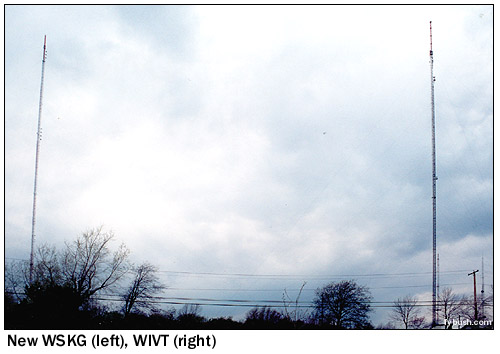 One more change
before we move north a bit - what was WYOS (104.1 Chenango Bridge) on the
WNBF center tower is now top 40 "Wild" WWYL. (The WYOS calls moved to the
former WKOP 1360, where they still reside.)
One more change
before we move north a bit - what was WYOS (104.1 Chenango Bridge) on the
WNBF center tower is now top 40 "Wild" WWYL. (The WYOS calls moved to the
former WKOP 1360, where they still reside.)
On to that Stainless tower: it's quite a bit emptier now than it was in 2000. Not only has WAAL moved away, but so has public broadcaster WSKG. With DTV on the way, WSKG moved all of its Ingraham Hill signals (WSKG-TV 46, WSKG-DT 42 and WSKG-FM 89.3) to a new 244-meter tower that went up last year adjacent to the WIVT site. And that tower ended up being the perfect spot for WHWK's new directional antenna, too. (WHWK nulls to the south, but all - and we mean all - of the market's population is to the north, so few noticed the change when 98.1 moved.)
Speaking of WIVT, it regained much of its momentum once its new tower went up. It didn't hurt that Clear Channel (which absorbed the Ackerley group) ended up acquiring the market's NBC affiliate as well. (A duopoly in market 154, with just three commercial stations? It's possible, you see, when the NBC is an LPTV, WBGH-CA, now operating on channel 20 from the WIVT tower and simulcasting WIVT's local newscasts. And since you're wondering, WB comes from "WBXI," a cable-only service operated by WBNG, while UPN shows up on WBPN-LP 10, which identifies with its cable position as "UPN 8" and is operated by WICZ from the Stainless tower.)
And there's one more bit of updating to be done to that 2000 material above: not long after that was written, WKGB (92.5 Conklin) moved from the remote Windsor site to the center tower of the WINR (680) array up on Windy Hill, providing a much-improved signal to Binghamton from the very spot where WINR-TV began all those years ago. Which reminds us that we never did get to that promised look at the rest of the Binghamton AM sites. We'll have to rectify that soon!
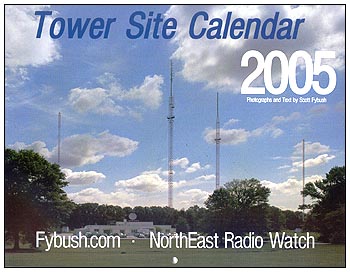 It's here - the 2005
Tower Site Calendar is now shipping! Click here for
ordering information!
It's here - the 2005
Tower Site Calendar is now shipping! Click here for
ordering information!
- Previous Site of the Week: Ventura County, California
- Next Week: We (Still) Love L.A.
- Site of the Week INDEX!
- How can you help support Site of the Week? Click here!
- Submit your suggestions for a future Site of the Week!
